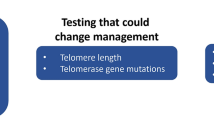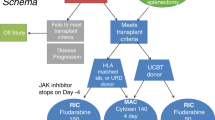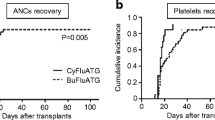Abstract
Myelodysplastic syndromes (MDS) are often associated with autoimmune processes that contribute to the cytopenias that characterize this disease group. Ten years ago, several investigators described improvement in the cytopenia of MDS following immunosuppressive treatments (IST) with antithymocyte globulin or cyclosporine. These findings have since been widely confirmed. The consensus is that about 30% of unselected transfusion-dependent patients with MDS given IST have sustained hematologic responses and can regain transfusion independence. Over the past decade, prognostic features have been defined that accurately identify the subset of patients most likely to benefit from IST. With increasing knowledge about the pathophysiology of myelosuppression in MDS, we are beginning to define the immunosuppressive agents and schedules with the greatest chance of causing hematologic improvement. Significantly, long-term follow-up indicates that IST responders have a better progression-free survival than comparable patients with MDS who do not receive IST.
Similar content being viewed by others
References and Recommended Reading
Barrett J, Saunthararajah Y, Molldrem J: Myelodysplastic syndrome and aplastic anemia: distinct entities or diseases linked by a common pathophysiology? Semin Hematol 2000, 37:15–29.
Barrett AJ, Sloand E, Young NS: Immunological mechanisms and treatment of MDS. In Myelodysplastic Syndromes: Clinical and Biological Advances. Edited by Greenberg PL. New York: Cambridge University Press; 2006.
Chen G, Zheng W, Miyazato A: Distinctive gene expression profiles of CD34 cells from patients with myelodysplastic syndrome characterized by specific chromosomal abnormalities. Blood 2004, 104:4210–4218.
Molldrem JJ, Jiang YZ, Stetler-Stevenson M, et al.: Hematological response of patients with myelodysplastic syndrome to antithymocyte globulin is associated with a loss of lymphocyte-mediated inhibition of CFU-GM and alterations in T cell receptor Vbeta profiles. Br J Haematol 1998, 102:1314–1322.
Young NS, Barrett AJ: Perspective: the treatment of severe acquired aplastic anemia. Blood 1995, 85:3367–3377.
Jonasova A, Neuwirtova R, Cermak J, et al.: Cyclosporin A therapy in hypoplastic MDS patients and certain refractory anaemias without hypoplastic bone marrow. Br J Haematol 1998, 100:304–309.
Molldrem JJ, Caples M, Mavroudis DA, et al.: Antithymocyte globulin for patients with myelodysplastic syndrome. Br J Haematol 1997, 99:699–705.
Sloand EM, Mainwaring L, Fuhrer M, et al.: Preferential suppression of trisomy 8 compared with normal hematopoietic cell growth by autologous lymphocytes in patients with trisomy 8 myelodysplastic syndrome. Blood 2005, 106:841–851.
Shimamoto T, Tohyama K, Okamoto T, et al.: Cyclosporin A therapy for patients with myelodysplastic syndrome: multicenter pilot studies in Japan. Leuk Res 2003, 27:783–788.
Atoyebi W, Bywater L, Rawlings L, et al.: Treatment of myelodysplasia with oral cyclosporin. Clin Lab Haematol 2002, 24:211–214.
Scheinberg P, Fischler S, Li L, et al.: Distinct EBV and CMV reactivation patterns following antibody-based immunosuppressive regimens in patients with severe aplastic anemia. Blood 2007, 109:3219–3224.
Molldrem JJ, Leifer E, Bahceci E, et al.: Antithymocyte globulin for treatment of the bone marrow failure associated with myelodysplastic syndromes. Ann Intern Med 2002, 137:156–163.
Aivado M, Rong A, Stadler M, et al.: Favourable response to antithymocyte or antilymphocyte globulin in low-risk myelodysplastic syndrome patients with a ‘non-clonal’ pattern of X-chromosome inactivation in bone marrow cells. Eur J Haematol 2002, 68:210–216.
Steensma DP, Dispenzieri A, Moore SB, et al.: Antithymocyte globulin has limited efficacy and substantial toxicity in unselected anemic patients with myelodysplastic syndrome. Blood 2003, 101:2156–2158.
Stadler M, Germing U, Kliche JO, et al.: A prospective, randomised, phase II study of horse antithymocyte globulin vs rabbit antithymocyte globulin as immune-modulating therapy in patients with low-risk myelodysplastic syndromes. Leukemia 2004, 18:460–465.
Yazji S, Giles J, Tsimberidou AM, et al.: Antithymocyte globulin (ATG)-based therapy in patients with myelodysplastic syndromes. Leukemia 2003, 17:2101–2106.
Killick SB, Mufti G, Cavenagh JD, et al.: A pilot study of anti-thymocyte globulin (ATG) in the treatment of patients with ‘low-risk’ myelodysplasia. Br J Haematol 2003, 120:679–684.
Deeg HJ, Jiang PY, Holmberg LA, et al.: Hematologic responses of patients with MDS to antithymocyte globulin plus etanercept correlate with improved flow scores of marrow cells. Leuk Res 2004, 28:1177–1180.
Sloand EM, Greenberg P, Wu C, et al.: Immunosuppressive treatment is associated with durable responses and a survival advantage in younger patients with int-1 myelodysplastic syndrome [abstract]. Blood 2005, 106(Suppl 1). Abstract 2519.
Melchert M, Kale V, List A: The role of lenalidomide in the treatment of patients with chromosome 5q deletion and other myelodysplastic syndromes. Curr Opin Hematol 2007, 14:123–129.
Saunthararajah Y, Nakamura R, Nam JM, et al.: HLA-DR15 (DR2) is overrepresented in myelodysplastic syndrome and aplastic anemia and predicts a response to immunosuppression in myelodysplastic syndrome. Blood 2002, 100:1570–1574.
Saunthararajah Y, Nakamura R, Wesley R, et al.: A simple method to predict response to immunosuppressive therapy in patients with myelodysplastic syndrome. Blood 2003, 102:3025–3027.
Greenberg P, Cox C, LeBeau MM, et al.: International scoring system for evaluating prognosis in myelodysplastic syndromes. Blood 1997, 89:2079–2088.
Barrett AJ, Savani BN: Allogeneic stem cell transplantation for myelodysplastic syndrome. Semin Hematol 2007, In press.
Barrett AJ, Rezvani K: Translational mini-review series on vaccines: peptide vaccines for myeloid leukaemias. Clin Exp Immunol 2007, 148:189–198.
Rezvani K, Yong A, Mielke S, et al.: Leukemia-associated antigen-specific T-cell responses following combined PR1 and WT1 peptide vaccination in patients with myeloid malignancies. Blood 2007, In press.
Author information
Authors and Affiliations
Corresponding author
Rights and permissions
About this article
Cite this article
Barrett, A.J., Sloand, E.M. Immunosuppressive therapy for myelodysplastic syndromes: Refining the indications. Curr Hematol Malig Rep 3, 23–28 (2008). https://doi.org/10.1007/s11899-008-0005-y
Published:
Issue Date:
DOI: https://doi.org/10.1007/s11899-008-0005-y




